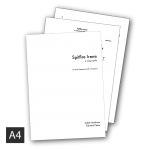Description
Daffodils
an Anglo-American Setting
For Baritone and Piano
Duration: ca. 3’30”
Words by Alan Gillott
Music by Edward Caine
“Daffodils was written on the 21st of March 2004, Morthering Sunday, when the I was stranded in England while my now wife was pregnant in Connecticut. In Church that day all the little ones were given a closed Daffodil to gve to their mothers and I was starkly reminded of my, as we then called ourselves, faux mari in the USA, and our foetus, which alas failed to thrive.” – Alan Gillott
I find the poem very beautiful and wished to set it in a very simple way. There are at best two or three musical ideas in the piece – the church bells, which start simply in the piano and then become more harmonically complex as the piece becomes more engaged, alighting on a chord which I had previously derived from the spectral analysis of a large bell and used in my orchestral piece R’lyeh. The second musical idea is the note that the singer plucks distractedly, echoing the bells and externalising his thought processes; A kind of emotional anchor, akin to a game that a psychologist might give to a child to distract them whilst talking about deep emotional issues. The third musical idea is just present in the harmony and direction of the voice leading in the piece, which is inspired chiefly by the songs of Samuel Barber, a falling step-wise harmonic gesture, slipping through modes in major thirds and always being a distance away from the tonality suggested by the vocal line.
The setting marks a kind of departure for me, in that unlike a lot of my pieces, I’ve explicitly used a harmony relating to more traditional diatonicism. I don’t think that this is important or remarkable in itself, but the point is that it shouldn’t be (important or remarkable); I’ve always thought of “Atonality” and “Tonality” as being misunderstood terms and the techniques and implications of both to be mere tools in a composer’s arsenal. It is rare that I bring out either set of tools to exemplify this idea but here I felt the setting required it.






Reviews
There are no reviews yet.